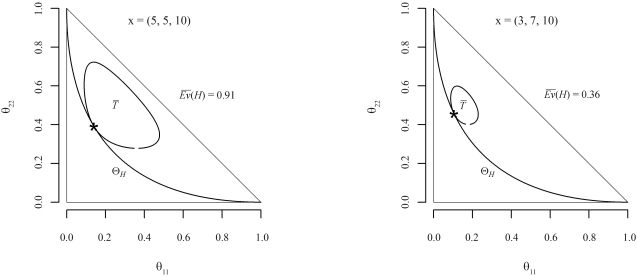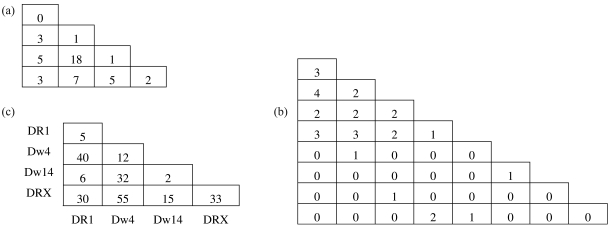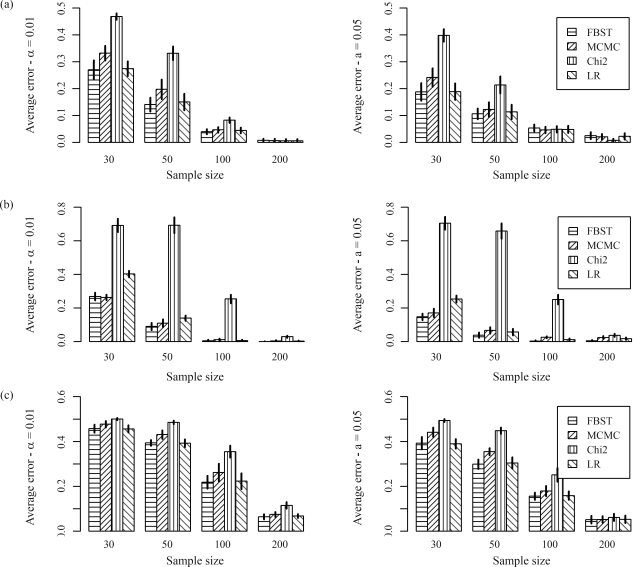Abstract
Much forensic inference based upon DNA evidence is made assuming Hardy-Weinberg Equilibrium (HWE) for the genetic loci being used. Several statistical tests to detect and measure deviation from HWE have been devised, and their limitations become more obvious when testing for deviation within multiallelic DNA loci. The most popular methods-Chi-square and Likelihood-ratio tests-are based on asymptotic results and cannot guarantee a good performance in the presence of low frequency genotypes. Since the parameter space dimension increases at a quadratic rate on the number of alleles, some authors suggest applying sequential methods, where the multiallelic case is reformulated as a sequence of “biallelic” tests. However, in this approach it is not obvious how to assess the general evidence of the original hypothesis; nor is it clear how to establish the significance level for its acceptance/rejection. In this work, we introduce a straightforward method for the multiallelic HWE test, which overcomes the aforementioned issues of sequential methods. The core theory for the proposed method is given by the Full Bayesian Significance Test (FBST), an intuitive Bayesian approach which does not assign positive probabilities to zero measure sets when testing sharp hypotheses. We compare FBST performance to Chi-square, Likelihood-ratio and Markov chain tests, in three numerical experiments. The results suggest that FBST is a robust and high performance method for the HWE test, even in the presence of several alleles and small sample sizes.
Keywords: Hardy-Weinberg equilibrium, significance tests, FBST
Introduction
The Hardy-Weinberg law is one of most important principles in population genetics, and establishes a direct relationship between allele and genotypic proportions in a population. This law states that in a large population of panmictic dioecious organisms with non-overlapping generations, the allelic and genotypic frequencies at a locus will stay unchanged, provided that migration, mutation, and natural selection do not affect that locus. When these conditions hold, it is said that the locus is under Hardy-Weinberg Equilibrium (HWE).
This principle was discussed independently by Yule, Pearson and Castle (between 1902 and 1904), for some particular allele frequencies (see references in Crow and Kimura, 1972). In 1908, Godfrey Hardy presented the general principle for two alleles (Hardy, 1908). This principle was called Hardy's law for 35 years, until Stern (1943) called attention to an article of Weinberg (1908) showing the same principle at the same time and demonstrating its validity for multiple alleles (Crow, 1999).
Since its postulation, several results in population genetics and much forensic inference based upon DNA evidence have been based on the assumption that HWE is valid for the genetic loci of interest. Some statistical tests to detect and measure deviation from HWE have been devised, and their limitations have become more obvious when testing for deviation within multiallelic DNA loci. The most common approach consists of goodness-of-fits tests, like Chi-square and Likelihood-ratio, which are heavily based on asymptotic results, and can sometimes lead to false rejection or acceptance of HWE when the sample sizes are small and/or some genotype sample frequencies are very small (Emigh, 1980). Another approach involves exact tests, but is restricted to small dimensions and allele numbers.
A Bayesian sequential method for multiallelic HWE test was proposed by Pereira et al. (2006), who suggested reformulating the multiallelic case as a sequence of “biallelic” tests. In that work, the central component is the Full Bayesian Significance Test (FBST), an intuitive Bayesian approach which does not assign positive probabilities to zero measure sets when testing sharp hypotheses (Pereira and Stern, 1999). Although the sequential method avoids the quadratic increase of parameter space dimension with respect to the number of alleles, it is not obvious how to assess the general evidence of the original hypothesis; nor is it clear how to establish the significance level for its acceptance or rejection (see DeGroot, 1970).
In this work, we propose a method for the multiallelic HWE test, based on the FBST. FBST has many theoretic and practical advantages over other approaches, and it has shown to be robust in several high-dimensional problems (Lauretto et al., 2008).
Background
In this section we introduce some notations, and the Hardy-Weinberg Equilibrium (HWE) formula. Let us consider k alleles A1, A2, ..., Ak in a locus. The main interest is to assess the population relative frequencies of the genotypes AiAj (i, j = 1, 2, ..., k) which we denote by pij. As usual in the literature (see Hardy, 1908), we assume that the allele frequencies do not depend on sex and thus are symmetric, that is, AiAj is equivalent to AjAi and pij = pji. Therefore, the parameter of interest is the (lower triangular) matrix of genotype proportions:
θ = (θij), with θii = pii, θij = 2pij for 1 ≤ j ≤ i ≤ k.
We denote by p1, p2, ..., pk the (unknown) population frequencies of alleles A1, A2, ..., Ak, with pi ≥ 0 and
 . When the locus is under HWE, the genotype proportions are as follows:
. When the locus is under HWE, the genotype proportions are as follows:
| (1) |
In order to test the HWE in a locus, one considers a sample of n individuals drawn randomly from the population. Such a sample can be presented as the array x, whose elements
 , are counts of genotypes AiAj. The sample size n is
, are counts of genotypes AiAj. The sample size n is
 , and the sample frequency of allele Ai is
, and the sample frequency of allele Ai is
 . Note that
. Note that
 , since all loci have two alleles and this sum is the number of alleles in the whole sample. The sample proportion of allele Ai,
, since all loci have two alleles and this sum is the number of alleles in the whole sample. The sample proportion of allele Ai,
 , is given by
, is given by
 |
(2) |
Assuming that each individual genotype does not depend on remaining individuals in the same generation, we can consider that the genotype frequencies xij follow a multinomial distribution with unknown parameter θ,
 |
(3) |
Testing Procedures
In this section we present three tests used in our comparative study. These and other approaches are described by Emigh (1980), Guo and Thompson (1992), Hernández and Weir (1989) and Montoya-Delgado et al. (2001).
Chi-square goodness-of-fit test
This test involves calculating the sample chi square value,
 |
(4) |
with
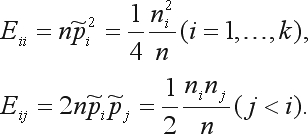 |
Under HWE, this quantity has a chi-square distribution with k(k – 1)/2 degrees of freedom.
The Chi-square goodness-of-fit test with continuity correction involves calculating the previous statistics, with the subtraction in each term of a correction constant c:
 |
(5) |
Usually c = 0.5 is the value chosen.
Likelihood-ratio tests
The likelihood function, given a sample, follows directly from the multinomial distribution presented in Eq. (3). A Likelihood-ratio test is constructed by comparing the likelihood maximized under the hypothesis, L0, with the maximum likelihood, L1, not constrained by the hypothesis. For HWE we have
 |
(6) |
with the sample allelic frequencies,
 , given by Eq. (2).
, given by Eq. (2).
The test statistic
 |
(7) |
is asymptotically distributed as a chi-square distribution with k(k – 1)/2 degrees of freedom.
Markov Chain Monte Carlo (MCMC) method
Proposed by Guo and Thompson (1992), the method consists of an adaptation of the Metropolis algorithm, with the construction of a Markov chain with equilibrium distribution matching the genotype probabilities under HWE of samples that have the same allelic counts as the observed data.
Under HWE and conditional on sample allele counts, n1, n2, ..., nk, the probability of obtaining the sample x is (see Levene, 1949):
 |
(8) |
Given the data x, the test evaluates
 |
(9) |
where
 and
and
| (10) |
{y: y has the same allele counts as does x}.
The MCMC algorithm is performed in order to estimate the probability P in E. (9). Rejection or acceptance of the null hypothesis depends on whether P is smaller than a pre-specified significance level α.
Methods
The Full Bayesian Significance Test (FBST)
The Full Bayesian Significance Test (FBST) was proposed by Pereira and Stern (1999) as a coherent and intuitive Bayesian test. It assumes that the hypothesis, H, is defined as a subset defined by inequality and equality constraints:
 |
(11) |
For simplicity, we often use H for ΘH. FBST is particularly focused on precise hypotheses: i.e., dim(ΘH) < dim(Θ). In this work,
 denotes the posterior probability density function, given the observation x. Bold 0 and 1 denote vectors of appropriate dimensions.
denotes the posterior probability density function, given the observation x. Bold 0 and 1 denote vectors of appropriate dimensions.
For the HWE test, the parametric space consists of all arrays of genotype proportions
| (12) |
The space on hypothesis is
 |
(13) |
As previously stated, we consider that the genotype frequencies x follow a multinomial distribution, given by Eq. (3). Taking as a priori the Dirichlet distribution with parameters (1,1...1), i.e., a uniform distribution, then the a posteriori is a Dirichlet distribution with parameters (x11 + 1, x21 + 1, x22 + 1, ..., xkk + 1) which is proportional to the likelihood function (DeGroot, 1970):
 |
(14) |
The computation of the evidence measure used on the FBST is performed in two steps:
1. The optimization step consists of finding the maximum (supremum) of the posterior under the null hypothesis,
 .
.
2. The integration step consists of integrating the posterior density over the Tangential Set, , where the posterior is higher than anywhere in the hypothesis, i.e.,
 |
(15) |
is the evidence against H, and = 1 – is the evidence supporting (or in favor of) H. For a better understanding of this evidence measure, Figure 1 illustrates two examples in the biallelic case, showing the null and tangential sets (ΘH and ). Since θ21 = 1 – θ11 – θ22, the parametric space is fully defined by homozygote proportions, θ11 and θ22. The parameter space corresponds to the area inside the triangle. Sample genotype counts for A11, A21, A22 and are also shown in each graph. Marker ‘*' represents the point θ* of maximum a posteriori density in the constrained space ΘH, and the level curve tangent to θ* corresponds to frontier. Intuitively, if the hypothesis set is in a region of “low” posterior density (as in the example 1), then is “heavy” and therefore is “large” (≅ 0.91), meaning “strong” evidence against H. On the other hand, as illustrated by the example 2, if hypothesis set is in a region of “high” posterior density, then is a “small” set, and hence Ev(H) is “small” (≅ 0.36), meaning “weak” evidence against H.
Figure 1.
Parameter space representation for two biallelic examples, x = (5,5,10) and x = (3,7,10), and the respective evidence against the HWE hypothesis.
For HWE test, the point
 is given as follows.
is given as follows.
Rewriting the posterior pdf under HWE, we have:
 |
(16) |
.
Taking its logarithm,
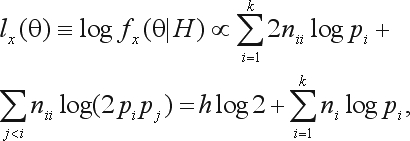 |
(17) |
where
 , and h is the sum of sample heterozygote frequencies,
, and h is the sum of sample heterozygote frequencies,
 .
.
By the constraint
 , we have:
, we have:
 |
(18) |
The gradients of lx(θ) are given by:
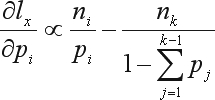 |
(19) |
Hence, the optimal point under HWE is given by the vector
 which satisfies:
which satisfies:
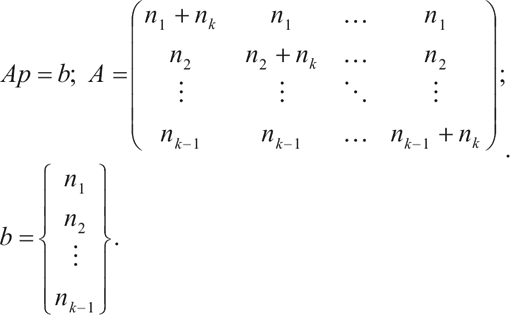 |
(20) |
Summing over all constraints and after some algebra, we obtain the following solution:
 |
.
The computation of θ* from p* follows from Eq. (1).
The integration step may be performed by generating a set of M points
 with a Dirichlet distribution with parameter (x11 + 1, x21 + 1, x22 + 1, ..., xkk + 1) and computing the percentage of points with posterior density greater than f*:
with a Dirichlet distribution with parameter (x11 + 1, x21 + 1, x22 + 1, ..., xkk + 1) and computing the percentage of points with posterior density greater than f*:
 |
(21) |
where I(stat) = 1 if stat is true and 0 otherwise. A more precise and efficient Monte Carlo method for the integration step is presented by Lauretto et al. (2003).
As with any significance test, this procedure requires the choice of a threshold level, τ, for acceptance/rejection of the hypothesis at a significance level α. Several alternative methods have been developed for establishing this threshold:
An empirical power analysis, developed by Stern and Zacks (2002) and Lauretto et al. (2003), provides critical levels that are consistent and also effective for small samples.
A threshold based on reference sensitivity analysis and paraconsistent logic is given by Stern (2004).
Pereira et al. (2008) relates the e-value threshold to standard p-value thresholds.
Madruga et al. (2001) proves the existence of a loss function that renders the FBST a true Bayesian decision-theoretic procedure.
An asymptotically consistent threshold for a given confidence level was given by Stern (2007), and Borges and Stern (2007), which we adopt in this work.
Let us consider the cumulative distribution of the evidence value against the hypothesis,
 , given θ0, the true value of the parameter. Under appropriate regularity conditions, for increasing sample size, we can state the following:
, given θ0, the true value of the parameter. Under appropriate regularity conditions, for increasing sample size, we can state the following:
If H is false,
 , then
converges (in probability) to one, that is,
, then
converges (in probability) to one, that is,
 .
.
If H is true,
 , then
, the confidence level, is approximated by the function Q(t, h, τ) =
, then
, the confidence level, is approximated by the function Q(t, h, τ) =
 , where t = dim(Θ), h = dim(H) and Chi2(df, x) denotes the cumulative chi-square distribution with df degrees of freedom.
, where t = dim(Θ), h = dim(H) and Chi2(df, x) denotes the cumulative chi-square distribution with df degrees of freedom.
Hence, to reject H with a significance level α, we can set
 , i.e., set τ such that
, i.e., set τ such that
 .
.
Results and Discussion
The numerical experiments used in the performance analysis are based on three typical datasets. Two examples consist of simulated data used in the literature as benchmarks for comparing the performance of competing methods, while the third example is from a real dataset. These examples are presented in Figure 2, as lower triangular matrices containing genotype frequencies. The first example is taken from Louis and Dempster (1987) and consists of a sample of size 45 of genotype frequencies distributed in four alleles. The second example is given by Guo and Thompson (1992) and consists of a sample of size 30 of simulated genotype frequencies simulated under HWE with underlying allele frequencies (0.2, 0.2, 0.2, 0.2, 0.05, 0.05, 0.05, 0.05). The third example is from a rheumatoid arthritis (RA) study performed by Wordsworth et al. (1992), where two hundred and thirty RA patients were genotyped for the HLA-DR locus. The DR4 allele was subdivided into Dw4, Dw14 and other subtypes. DRX represents all non-DR1, non-Dw4, non-Dw14 alleles. This example is used by Chen and Thomson (1999) as a benchmark.
Figure 2.
Datasets for numerical experiments, given by Louis and Dempster (1987) (a), Guo and Thompson (1992) (b) and Wordsworth et al. (1992) (c).
Our main interest is to compare the error convergence of FBST and other methods presented in this work (MCMC, Chi-square and Likelihood-ratio) for increasing sample sizes. For each sample size
 , we simulated two collections of 100 samples. The first collection consists of samples drawn under HWE, i.e., each sample is drawn with a multinomial distribution with parameters (n, θ*), with
, we simulated two collections of 100 samples. The first collection consists of samples drawn under HWE, i.e., each sample is drawn with a multinomial distribution with parameters (n, θ*), with
 . The second collection consists of samples drawn with a multinomial distribution with parameters (n, θ(h)), where θ(h) is drawn under the posterior distribution. That is, each sampling iteration is performed in two steps:
. The second collection consists of samples drawn with a multinomial distribution with parameters (n, θ(h)), where θ(h) is drawn under the posterior distribution. That is, each sampling iteration is performed in two steps:
a) draw
 , where xij (1 ≤ j ≤ i ≤ k) are the frequencies in the original dataset; and
, where xij (1 ≤ j ≤ i ≤ k) are the frequencies in the original dataset; and
b) draw
 .
.
The Type I error (rejection rate of a true hypothesis) is estimated by the proportion of samples in collection 1 such that HWE is rejected, and the Type II error (acceptance rate of a false hypothesis) is estimated by the proportion of samples in collection 2 such that HWE is accepted. The performance criterion used in this work is the average error, i.e., the average of Types I and II error rates. Two standard significance levels, α ∈ {0.01, 0.05}, were used to calibrate the asymptotic acceptance/rejection threshold of each method.
A variability measure for the errors was obtained by performing 10 batches of simulations and computing the mean and standard deviation of average errors across the batches.
Figure 3 presents the average errors for FBST, MCMC, Chi-square (with continuity correction) and Likelihood ratio for simulated data based on examples 1, 2 and 3. The bar height represents the mean of average errors, and the vertical line on the top of each bar is the error bar, representing the mean ± one standard deviation of average errors.
Figure 3.
Average error rates for FBST, MCMC, Chi-square and Likelihood-ratio for simulated data based on examples from Louis and Dempster (1987) (a), Guo and Thompson (1992) (b) and Wordsworth et al. (1992) (c).
For simulated data based on examples 1 and 3, the best competitors are FBST and Likelihood-ratio test, while for simulated data based on example 2, the best competitors are FBST and MCMC. In every case, we notice that FBST is always the best competitor (especially for small sample sizes, n ≤ 100) or is very close to it.
These numerical results suggest that FBST is more stable than the competitors discussed in this paper, in the sense that it has good comparative performance for different datasets and allele numbers.
Final Remarks
We have introduced a simple and straightforward procedure for testing deviance from Hardy-Weinberg Equilibrium (HWE) in the presence of several alleles. This procedure was implemented in C language, and integrated into a system for parentage testing developed with FAPESP support, where it is applied in the selection of loci to be used for parentage testing. Further details of this project can be found at http://watson.fapesp.br/PIPEM/Pipe13/genet1. htm. Currently, the routine is available by request to the corresponding author.
Acknowledgments
The authors are grateful for the support of EACH-USP, IQ-USP, IME-USP, Coordenação de Aperfeiçoamento de Pessoal de Nível Superior (CAPES), Conselho Nacional de Desenvolvimento Científico e Tecnológico (CNPq) and Fundação de Apoio à Pesquisa do Estado de São Paulo (FAPESP).
References
- Borges W., Stern J.M. The rules of logic composition for the Bayesian epistemic e-values. Logic J IGPL. 2007;15:401–420. [Google Scholar]
- Chen J.J., Thomson G. The variance for the disequilibrium coefficient in the individual Hardy-Weinberg test. Biometrics. 1999;55:1269–1272. doi: 10.1111/j.0006-341x.1999.01269.x. [DOI] [PubMed] [Google Scholar]
- Crow J.F., Kimura M. An Introduction to Population Genetics Theory. New York: Harper & Row; 1972. [Google Scholar]
- Crow J.F. Hardy, Weinberg and language impediments. Genetics. 1999;152:821–825. doi: 10.1093/genetics/152.3.821. [DOI] [PMC free article] [PubMed] [Google Scholar]
- DeGroot M.H. Optimal Statistical Decisions. New York: Wiley; 1970. [Google Scholar]
- Emigh T.H. A comparison of tests for Hardy-Weinberg equilibrium. Biometrics. 1980;36:627–642. [PubMed] [Google Scholar]
- Guo S.W., Thompson E.A. Performing the exact test of Hardy-Weinberg proportion for multiple alleles. Biometrics. 1992;48:361–372. [PubMed] [Google Scholar]
- Hardy G.H. Mendelian proportions in a mixed population. Science. 1908;28:49–50. doi: 10.1126/science.28.706.49. [DOI] [PubMed] [Google Scholar]
- Hernández J.L., Weir B.S. A disequilibrium coefficient approach to Hardy-Weinberg testing. Biometrics. 1989;45:53–70. [PubMed] [Google Scholar]
- Lauretto M.S., Pereira C.A.B., Stern J.M., Zacks S. Full Bayesian significance test applied to multivariate normal structure models. Braz J Probabil Stat. 2003;7:147–168. [Google Scholar]
- Lauretto M.S., Pereira C.A.B., Stern J.M. The full Bayesian significance test for mixture models: Results in gene expression clustering. Genet Mol Res. 2008;7:883–897. doi: 10.4238/vol7-3x-meeting06. [DOI] [PubMed] [Google Scholar]
- Levene H. On a matching problem arising in genetics. Ann Math Stat. 1949;20:91–94. [Google Scholar]
- Louis E.J., Dempster E.R. An exact test for Hardy-Weinberg and multiple alleles. Biometrics. 1987;43:805–811. [PubMed] [Google Scholar]
- Madruga M., Esteves L.G., Wechsler S. On the Bayesianity of Pereira-Stern tests. Test. 2001;10:291–299. [Google Scholar]
- Montoya-Delgado L.E., Irony T.Z., Pereira C.A.B., Whittle M.R. An unconditional exact test for the Hardy-Weinberg equilibrium law: Sample-space ordering using the Bayes factor. Genetics. 2001;158:875–883. doi: 10.1093/genetics/158.2.875. [DOI] [PMC free article] [PubMed] [Google Scholar]
- Pereira C.A.B., Nakano F., Stern J.M., Whittle M.R. Genuine Bayesian multiallelic significance test for the Hardy-Weinberg equilibrium law. Genet Mol Res. 2006;5:619–631. [PubMed] [Google Scholar]
- Pereira C.A.B., Stern J.M. Evidence and credibility: Full Bayesian significance test for precise hypotheses. Entropy J. 1999;1:69–80. [Google Scholar]
- Pereira C.A.B., Stern J.M., Wechsler S. Can a significance test be genuinely Bayesian? Bayesian Anal. 2008;3:79–100. [Google Scholar]
- Stern C. The Hardy-Weinberg law. Science. 1943;97:137–138. doi: 10.1126/science.97.2510.137. [DOI] [PubMed] [Google Scholar]
- Stern J.M., Zacks S. Testing the independence of Poisson variates under the Holgate bivariate distribution. The power of a new evidence test. Stat Probabil Lett. 2002;60:313–320. [Google Scholar]
- Stern J.M. Inconsistency analysis for statistical tests of hypothesis. In: López-Díaz M., Gil M.A., editors. Soft Methodology and Random Information Systems. New York: Springer; 2004. pp. 567–574. [Google Scholar]
- Stern J.M. Cognitive constructivism, eigen-solutions and sharp statistical hypotheses. Cybernet Hum Knowing. 2007;14:9–36. [Google Scholar]
- Weinberg W. Über den Nachweis der Vererbung beim Menschen. Jahresh Wuertt Verh Vaterl Naturkd. 1908;64:369–382. [Google Scholar]
- Wordsworth P., Pile K.D., Buckley J.D., Lanchbury J.S.S., Ollier B., Lathrop M., Bell J.I. HLA heterozygosity contributes to susceptibility to rheumatoid arthritis. Am J Hum Genet. 1992;51:585–591. [PMC free article] [PubMed] [Google Scholar]



